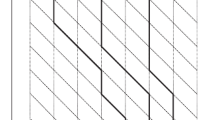Summary
Assuming the usual analyticity for mesonic Regge trajectories we correlate the asymptotic (power) behaviour of the trajectories with the number of complex zeros of the functionα(s) —N, N being an integer of adequate parity. Trajectories that grow nearly linearly do not have such zeros.
Riassunto
Adottando l’usuale analiticità per le traiettorie di Regge mesoniche, si mette in relazione il comportamento asintotico (di potenze) delle traiettorie con il numero di zeri complessi della funzioneα(s) —N, in cuiN è un intero di adeguata parità. Le traiettorie che crescono quasi linearmente non hanno zeri di questo tipo.
Реэюме
Предполагая обычную аналитичность для меэонных траекторий Редже, мы свяэываем асимптотическое (степенное) поведение зтих траекторий с числом комплексных нулей функции α(s) —N, гдеN целое число. Траектории, которые растут почти линейно, не имеют таких нулей.
Similar content being viewed by others
References
The statements we make, rather liberally, about the basic framework of Regge theory can all be found in the masterly review byR. Oehme:Complex angular momentum, inStrong Interactions and High-Energy Physics, edited byR. G. Moorhouse (London, 1964).
V. de Alfaro andT. Regge:Potential Scattering (Amsterdam, 1965).
E. C. Titchmarsh:The Theory of Functions, 2nd edition (Oxford, 1960).
H. Fleming andE. Predazzi:Lett. Nuovo Cimento,4, 556 (1970);H. Fleming andT. Sawada:Lett. Nuovo Cimento,26, 1045 (1971);H. Fleming:Lett. Nuovo Cimento,3, 363 (1972).
R. Oehme:Complex Regge trajectories, preprint from the Enrico Fermi Institute, EFI 71-26 (1971), and references therein.
S. W. Mac Dowell:Phys. Rev.,112, 1344 (1959).
H. Fleming:Maximum behaviour of Regge trajectories at infinity, preprint from São Paulo (1972).
R. W. Childers:Phys. Rev. D,2, 1178 (1970).
H. Fleming:Lett. Nuovo Cimento,3, 363 (1972).
E. C. Titchmarsh:The Theory of Functions, 2nd edition (Oxford, 1960).
R. W. Childers:Phys. Rev. D,2, 1178 (1970).
M. Sugawara andA. Tubis:Phys. Rev.,130, 2127 (1963).
G. Frye andR. L. Warnock:Phys. Rev.,130, 478 (1963).
A. I. Markushevich:Theory of Functions of a Complex Variable, Vol.2 (Englewood Cliffs, N. J., 1965), p. 226. To be fair, this theorem seems to have been proved first byJ. Hadamard.
E. C. Titchmarsh:The Theory of Functions, 2nd edition (Oxford, 1960).
H. Fleming andE. Predazzi:Lett. Nuovo Cimento,4, 556 (1970). See alsoA. Degasperis andE. Predazzi:Nuovo Cimento,65 A, 764 (1970).
Author information
Authors and Affiliations
Additional information
To speed up publication, the authors of this paper have agreed to not receive the proofs for correction.
Rights and permissions
About this article
Cite this article
Fleming, H., Filho, A.M. Upper bounds for the asymptotic behaviour of Regge trajectories. Nuov Cim A 14, 215–223 (1973). https://doi.org/10.1007/BF02734615
Received:
Published:
Issue Date:
DOI: https://doi.org/10.1007/BF02734615




